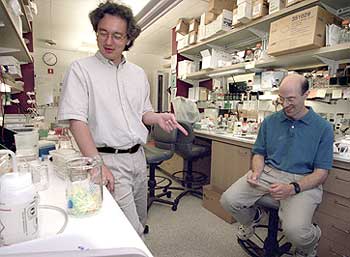 |
|||||||||
|
Research Feature Stories: Other News: |
Proteins Collaborate to Carry Out Cellular Activities
Two-hybrid system created
Disease at its core involves faulty protein interactions, according to Dr. Stanley Fields, UW professor of genome sciences and medicine and a Howard Hughes Medical Institute investigator. One can think of each cell as a bag containing thousands of proteins that fit together in sets of pieces as in a puzzle. Proteins in the cell talk to other proteins, give them messages and tell them what to do. When cells don’t perform correctly—as with cancer cells that grow uncontrollably, for example—there is a flaw in some cellular process, and understanding protein interactions may be key to identifying the cause and, ultimately, the cure.
|
Dr. Stanley Fields (right) directs the work of his lab in mapping and characterizing protein complexes. |
 |
In 1989, Fields and his colleagues developed a methodology for finding protein interactions. Since that time, other methods have been developed and used with success, but Fields’ system has become the dominant tool among researchers throughout the world. The American Society for Microbiology News called it as much of a staple in molecular biology labs as the microwave oven is in kitchens.
The two-hybrid system, as it is known, uses two different hybrid proteins—one containing a DNA-binding domain and the other a transcriptional activation domain—to detect protein-protein interactions in yeast cells. As the approach became common practice, researchers began to investigate many biological processes by identifying protein interactions. The value of a comprehensive protein interaction map and the potential for producing one also became apparent.
|
Methods originated at the UW for analyzing protein interactions are now common in labs around the world. |
 |
In 1995 Fields and his colleagues began planning a large-scale analysis of yeast protein-protein interactions. The two-hybrid system came along at a timely moment, Fields said: “A burgeoning supply of proteins to analyze was becoming available, initially from more traditional biochemical and genetic approaches, and more recently from genome sequencing. In addition, the procedure is relatively easy to perform. A common response of the biologist first scoring a successful two-hybrid search is outright disbelief that an assay so simple can be so revealing of the innermost circuitry of a cell.”
Fields’ lab is conducting a number of projects, including mapping and characterizing protein complexes in yeast and seeking to find proteins involved in Huntington’s chorea and other diseases. The lab also helped in developing a three-hybrid system for examining RNA-protein interactions.
The Emerging Field of Protoeomics
In the Feb. 16, 2001, issue of Science magazine, Fields looked to the future and envisioned the emerging importance of understanding how protein interactions carry out cellular functions in the body.
“In the wonderland of complete sequences,” he said, “there is much that genomics cannot do. So the future belongs to proteomics: the analysis of complete complements of proteins. Proteomics includes not only the identification and quantification of proteins, but also the determination of their localization, interactions, activities and, ultimately, their function.”
Although he sees a shift from genomics to proteomics, Fields also appreciates the complications: “A proteome (the complement of proteins expressed by a genome) may be an order of magnitude more complex than the genome itself. What’s more, proteins respond to altered conditions by changing their location within the cell, getting cleaved into pieces, and adjusting their stability as well as changing what they bind to. Lastly, a single protein may participate in more than one process, and conversely, similar func-tions may be carried out by different proteins.”
This past spring the American Academy of Microbiology awarded Fields the 2000 Chiron Corporation Biotechnology Research Award. For his achievements in the study of protein interactions, Fields was elected to membership in the National Academy of Sciences.
|
| UW AMC Medical Center | UW School of Medicine | Harborview | UW MC | Search UW AMC | UW Home | Contact Us | ©2001-2002, University of Washington Academic Medical Center. All rights reserved. Please honor our copyrights. |
|